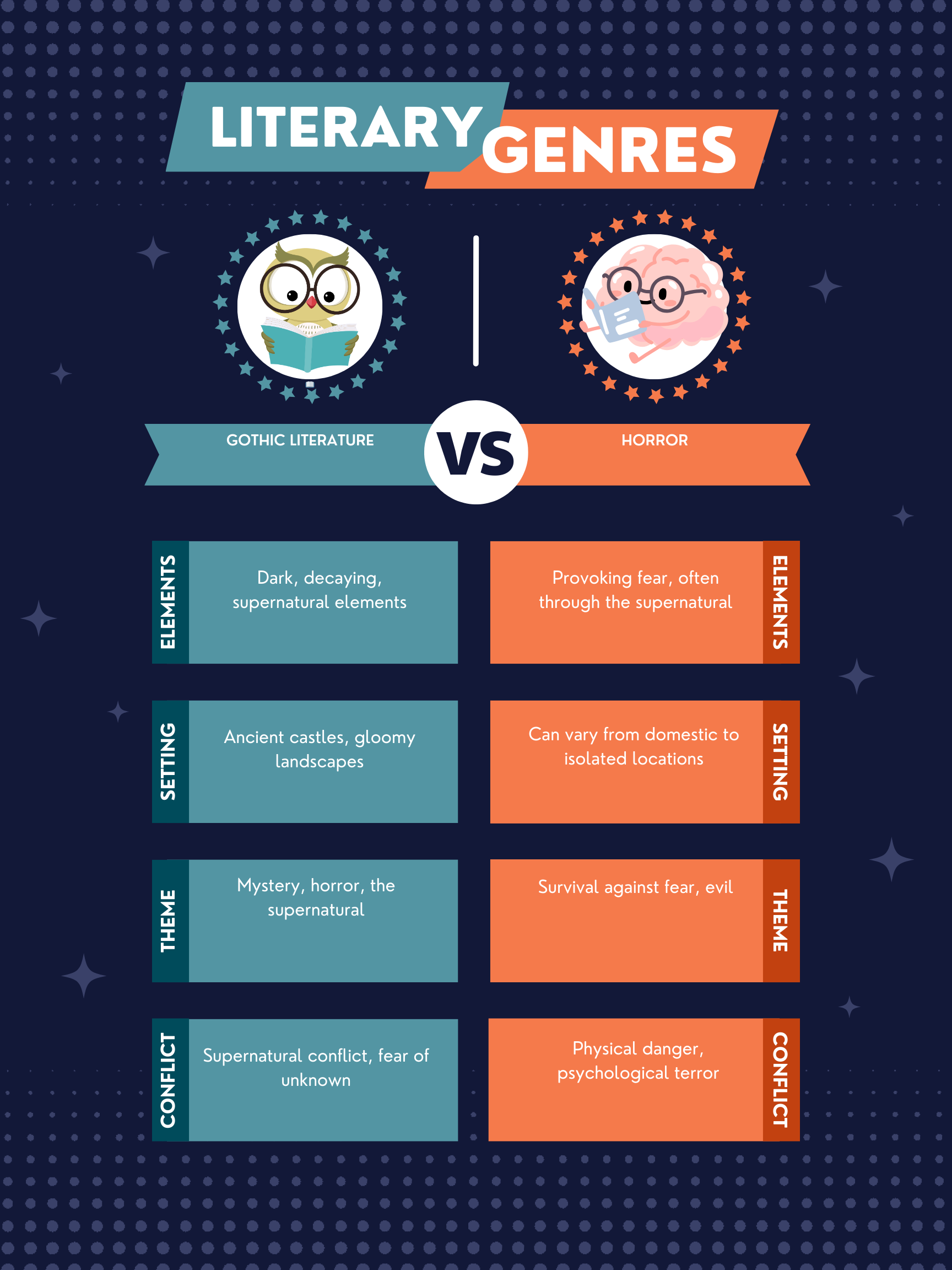Gothic Literature combines fiction, horror, death, and romance, often set in gloomy castles or landscapes to evoke dread; Horror focuses on creating feelings of fear, horror, and disgust in the audience.
Gothic Literature and Horror both delve into the darker aspects of human experience, yet they do so in ways that uniquely define their genres. 🏰💀
Gothic Literature
Gothic Literature is known for its complex characters, intricate plots, and settings that are as important as the characters themselves. It explores themes of madness, decay, and the supernatural, often against a backdrop of decayed or eerie settings like old mansions or desolate landscapes. “Dracula” by Bram Stoker is a quintessential example, combining elements of horror with a Gothic setting and a sense of romanticism.
Horror
Horror aims to evoke a visceral reaction from its audience, be it fear, shock, or disgust. It often involves supernatural elements, monsters, or situations that put its characters in extreme peril. Stephen King’s “The Shining” exemplifies modern horror, using isolation, the supernatural, and psychological deterioration to create tension and fear.
Summary
| Literary Device | Definition | Purpose | Usage | Relevant Examples |
|---|---|---|---|---|
| Gothic Literature | Combines fiction, horror, death, and romance in gloomy settings. | To evoke dread and explore complex themes through setting and mood. | Novels, short stories. | “Dracula” by Bram Stoker. |
| Horror | Focuses on creating feelings of fear, horror, and disgust. | To elicit a visceral reaction and explore the limits of human endurance and morality. | Novels, films, short stories. | “The Shining” by Stephen King. |
Writing Tips
For Gothic Literature:
- Emphasize Setting: Create an atmospheric setting that reflects the themes of your story.
- Develop Complex Characters: Characters should have depth and secrets, contributing to the overall mystery.
- Incorporate Romance and Horror: Weave these elements together to create a multifaceted narrative.
For Horror:
- Build Tension: Gradually increase the stakes and danger to keep readers on edge.
- Utilize Fear: Explore different aspects of fear—psychological, physical, existential—to affect the audience deeply.
- Create Realistic Reactions: Characters’ responses to terrifying situations should feel genuine and relatable.
FAQs
Can a work be both Gothic and Horror?
Yes, many works blend elements of both, using Gothic settings and themes to amplify the horror aspect.
How do I choose between writing Gothic Literature and Horror?
Consider what you want to explore in your story. If you’re drawn to atmospheric settings and complex themes intertwined with horror and romance, Gothic Literature might be your avenue. If you aim to elicit fear and explore the darker side of humanity directly, Horror could be the better choice.
Exercise
Read the following excerpt: “The ancient house, perched atop the desolate moor, hid secrets in its shadows. Whispers of the past echoed through the halls, telling tales of unrequited love and untimely death.”
Answer: This passage leans towards Gothic Literature, with its emphasis on setting, atmosphere, and the intertwining of romance and death.
Other Interesting Literary Device Comparisons
- Allegory vs Symbolism: Allegories use characters and narratives to represent broader themes and moral lessons, while symbolism involves objects, characters, or actions that signify ideas and concepts beyond their literal meaning.
- Metaphor vs Simile: Both compare two things, but metaphors do so directly (“Life is a journey”), while similes use “like” or “as” (“Life is like a journey”).
- Fable vs Parable: Fables are short stories usually with animal characters that teach a moral lesson, whereas parables are simple stories used to illustrate a moral or spiritual lesson, often human-centered.
Exploring Gothic Literature and Horror reveals the depth and variety of ways in which writers can explore and evoke the darker, more mysterious aspects of life and human nature. 📖🖤

